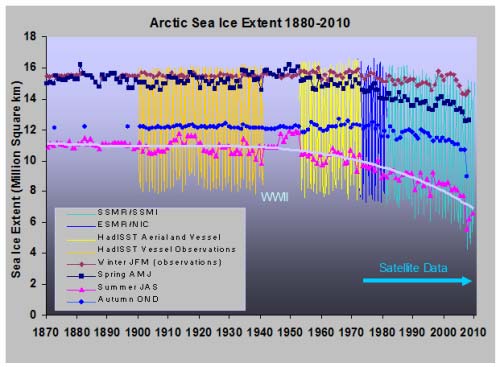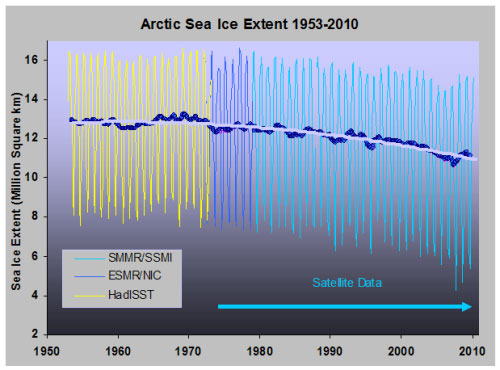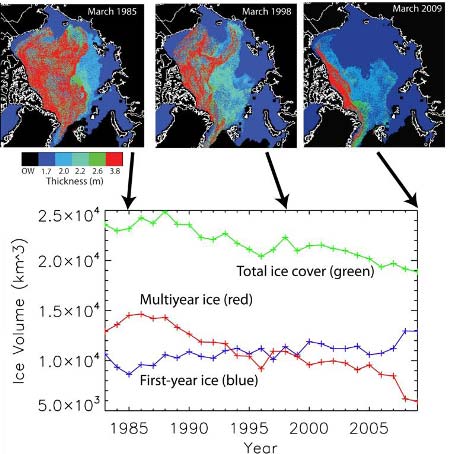Arctic Sea Ice (Part 1): Is the Arctic Sea Ice recovering? A reality check
Posted on 12 April 2010 by Peter Hogarth
Guest post by Peter Hogarth
The dramatic downwards trend in the annual summer extent of Arctic sea ice - and marginal increase in Antarctic sea ice have both sparked intense debate and commentary. Viewed in a global context, the amounts of polar sea ice are relatively small compared with the massive total volumes of ice in the land based ice caps of Antarctica, Greenland, and the Himalayas. If we take into account the observations of recent accelerating ice mass loss from these areas, plus the mean length, thickness and mass loss from the worlds glaciers (and we consider that the often cited Antarctic sea ice is significantly thinner on average than the Arctic sea ice, and much smaller in extent during the melt season), it is evident that the global reservoir of perennial ice is diminishing. Coupled with the evidence of mean ground permafrost temperatures in all Arctic regions rising towards critical melt threshold over the past three decades, the evidence of ongoing average ice melt is global in extent and is currently following an accelerating trend. The relatively thin layer of sea ice floating on the Arctic Ocean appears especially vulnerable, and the clear multi-decadal decline in summer extent has become one of the most compelling indicators of recent climate change.
However it has been claimed that since 2007 the Arctic ice has been recovering. What does the actual data from Arctic studies show? Here we look at recent data and multiple strands of independent evidence to see if this claim has any basis in reality. Temperature, almost by definition, is the main factor that governs seasonal melting and re-freezing of ice. The amount of Arctic sea ice can almost be regarded as a self calibrating proxy for regional temperature, but there are several inter-related dynamic factors driving the high latitude weather patterns, air and oceanic temperatures, currents, and thus ice area and thickness. These causal factors will be the subject of a future post. Certainly, average temperature over the central Arctic has increased more than in any other region of the planet over at least the last fifty years, and the average length of the ice melt season has significantly increased over the past three decades (Markus 2009, Howell 2009, Rodrigues 2009).
The “extent” of sea ice (usually defined as area of the ocean covered by more than 15% of ice) is most commonly used when discussing changes in Arctic ice. Unlike the Antarctic case, the growth of Arctic ice area in winter is constrained by the land masses which almost completely surround the Arctic Ocean.
Credit for AOOS (Alaska Ocean Observation System) data Cavalieri, Markus, and Comiso. 2004. AMSR-E/Aqua Daily L3 12.5 km Brightness Temperature, Sea Ice Concentration, & Snow Depth Polar Grids V002, 2002 to 2009. Boulder, Colorado USA: National Snow and Ice Data Center.
For the Arctic, there are records of the annually advancing and receding ice edge on charts going back to the beginning of the 20th Century and some from even earlier (Walsh 1978, Mahoney 2008, Vinje 2003). It is possible to reconcile the early ice chart and aerial reconnaissance data with satellite data processed for ice edge, despite technical difficulties and several different algorithms and definitions (Comiso 2008, Comiso 2009, Spreen 2008, Anderson 2007). There are enough recent overlapping independent data series to attempt to resolve these differences and develop long term climatic records with quantifiable errors (Walsh and Chapman 2001, Rayner 2003, Bronnimann 2008, Cavalieri 2003, Scott and Meier 2010).
Looking at the long term trend of Arctic ice extent using satellite data back to 1972, and linking them as best we can to historical observations going back to the late 19th Century, there is a dramatic downwards trend, though shorter term, decadal (and regional) variations are apparent. These variations are relatively small compared with the seasonal variation between September minimums and March maximums.

Long term seasonal trends in Arctic Ice extent. The data from HadISST and the ESMR “merged” data have been normalized to the SSMR and SSM/I record. The trend line is fitted to the three Summer month mean values (Walsh and Chapman 2001). The HadISST record from 1900 to 1944 is interpolated data fitted to observations and chart data, and uncertainties are larger.

Higher resolution seasonal data and annual average values with trend from 1953 onwards.
In 2007, there was a large decrease in summer Arctic sea ice extent. By this time the summer minimum had diminished to around 40% of the 1979 to 2000 average. The amplitude of the swing between summer and winter extents has also increased, partially as a result of the increasing proportion of young ice forming in winter and more rapidly melting in summer in the warming Arctic environment (Goosse 2009).
It can be seen that in 2008 and 2009, the summer minimum sea ice extent increased slightly from the very low 2007 value. So does this mean that the arctic sea ice is recovering? Looking at the long term trends, the average long term decline is accelerating (Comiso 2008). It seems unlikely that this trend could be reversed over the course of two or even three years, and several periods of temporary multi-year increase are evident in the record. Are extents in 2008, 2009 and 2010 any different through the rest of the annual cycle? Let us zoom in further.
Animation of annual trends over the SSMR and SSMI satellite sensor period, month by month. All trends are significantly negative.
With hindsight and the benefit of two more years worth of data it is possible to view the anomalous 2007 decrease in ice extent as a temporary deviation away from the longer term downward trend (similar to those in 1990 or 1995). This trend appears to continue below model predictions (Stroeve 2007) and though recent refinements to climate modeling work has shown that an imminent dramatic change in this trend or “tipping point” is unlikely, at least in the Arctic (Notz 2009, Eisenmann and Wettlaufer 2009), these models still suggest a substantially Ice free Arctic before 2100 (Wang 2009, Boé 2009, Zhang 2010).
Can we say anything else about the amount of sea ice? Extent is the most visible proxy for the total amount of ice, and as we have seen we have relatively good ice boundary records for many Arctic regions for most of the 20th Century. Extent is important but to determine the total amount of ice we need observations of ice thickness in order to estimate ice volume. Ice thickness data from before the 1950s is sparse. Recently declassified submarine sonar based data from 1958 onwards, covering more than 38% of the Arctic Ocean, shows that overall ice thickness has almost halved in the past 30 years, and the thinning trend is accelerating (Kwok and Rothrock 2009). Observations over the whole Arctic region from before 2007 showed that the reducing ice extent was accompanied by a significant reduction in older sea ice (Rigor 2004), and a corresponding reduction in overall ice thickness (Yu and Maykut 2004, Lindsay 2009, Wang 2010, Shirasawa 2009). This average Arctic thinning trend, as measured by satellite radar altimetry (Giles 2008) and ICESat satellite laser altimetry (Kwok 2009), continued through 2008 and 2009 despite the increase in minimum ice extent. The loss of older ice has also continued through 2009 (Nghiem 2010). Satellite radar backscatter (QuikSCAT) data, which can highlight textural differences between new and older ice, cross checked with airborne and surface data records from 2008 and 2009 confirm that the winter perennial ice extent had reduced to the lowest levels on record.
Arctic wide studies show that the ice loss has not been constant or uniform over the entire Arctic area. Over the past ten years older ice around the North pole towards Siberia has diminished rapidly, whilst an area North of the Canadian Coast remains least affected (Agnew 2010, Haas 2010).
Movie of QuikSCAT 13GHz RADAR Scatterometer data clearly showing build up of new first year ice and areas of older ice, and the changes in overall extent and reductions in older ice from 2000-2009. Credit for images David Long, Brigham Young University, JPL NASA.
Even here, ice shelves which are estimated to be more than 3000 years old have “calved” or fractured since 2000, and recent voyages have provided direct observational data (Barber 2010, Barber 2009) showing that many areas reported as multi-year ice in 2009 by satellite sensors was in fact “rotten”, containing approximately 25% open water. Thus 2009 ice coverage as reported by satellites is likely to be an overestimate. Even so the satellite records showed that at the end of summer 2009, whilst about a third of the ice cover was second-year ice (an increase in proportion over 2007) multi year ice had reduced to a fifth of the total ice cover, the lowest in the satellite record. When age, thickness and extent are all combined, the total volumes of Arctic Sea ice through 2008 and 2009 are also estimated to be the lowest on record (Maslowski 2010, Tschudi 2010, press release). However it is the fact that these estimates are the most recent points on longer term downwards trends in extent, thickness and volume that is most important. Against this background, claims of recovering Arctic ice are not supported by the overall evidence.

Estimates of ice volume since 1985(from Tschudi 2010) Image credit Jim Maslanik and Chuck Fowler, Colorado University, and Ron Kwok, JPL (NASA)
Although at the end of March 2010 Arctic ice extent enjoyed a brief anomalous increase due to cold weather conditions in the Bering and Barents seas, this ice is thin and young, and though there is also an increased proportion of overall second year ice since 2009, much of this has formed North of the Fram Strait and also in a large lobe North of Alaska along with a proportion of the remaining multi-year ice. Based on recent patterns of ice melt and motion it is likely that the scene is set for significant loss through 2010.
Viewed in a global context the amounts of polar sea ice are small compared with the massive total volumes of ice in the land based ice caps of Greenland, Antarctica, and the Himalayas. The Arctic sea ice is a diminishing and progressively thinning layer floating on the Arctic Ocean, and this makes it increasingly fragile and vulnerable to a number of related mechanisms which are likely to further enhance ice loss. The consequences of this loss for the inhabitants of the region could be profound (Ford 2009).































 Arguments
Arguments
























 0
0  0
0






Comments